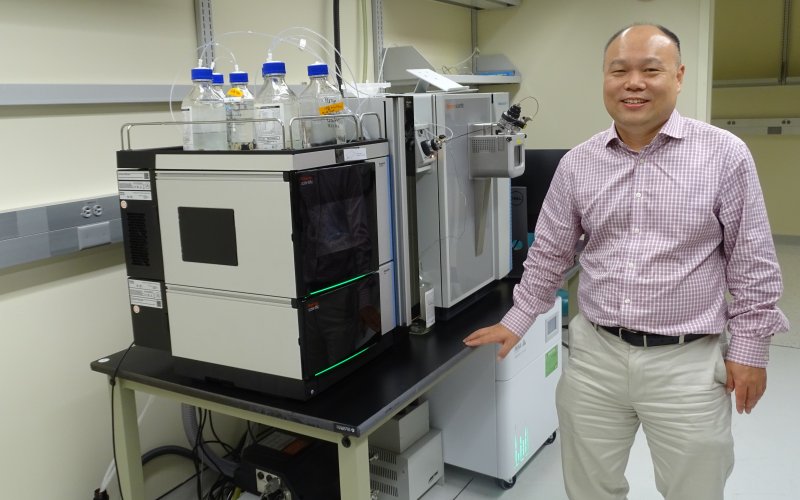UAlbany Chemist Receives Federal Support to Advance Tool for Complete RNA Sequencing

By Erin Frick
ALBANY, N.Y. (Oct. 24, 2024)—University at Albany’s Shenglong Zhang, associate professor in the Department of Chemistry and the RNA Institute, has received two Small Business Technology Transfer (STTR) grants from the National Institutes of Health totaling over $620,000. The grants were jointly awarded to the University and UAlbany spinoff company DirectSeq Biosciences, Inc., which Zhang has directed as founder and president since November 2022.
DirectSeq Biosciences specializes in direct sequencing RNA extracted from biological samples—things like cells, tissues, and body fluids—in order to reveal patterns and anomalies that signal problems, like disease. Unlike conventional RNA sequencing methods that eliminate information on RNA modifications, Zhang’s newly developed sequencing approach, described in the Journal of the American Chemical Society, achieves an unprecedented level of granularity for identifying all RNA modifications without bias, with potential to improve applications in disease diagnosis, treatment and advanced personalized medicine.
Zhang currently works with partners such as the University of Chicago and Cornell Medical School to analyze their samples and provide RNA sequence information. The projects supported by the new STTR grants will bring Zhang’s RNA sequencing techniques into a broader user base, with potential clients including academic researchers, biopharmaceutical companies engaged in developing RNA-based vaccines and therapeutics, federal agencies overseeing RNA drugs, and medical clients focused on RNA-based diagnosis and treatment.
Here, Zhang sheds light on his work in RNA sequencing and the importance of honing tools that afford a complete picture of the molecular building blocks that regulate our health.
What is DNA/RNA sequencing?
Sequencing refers to the general laboratory technique for determining the exact sequence of nucleotides, or bases, in a DNA or RNA molecule. Bases are often referred to by the first letters of their chemical names: A (adenine), C (cytosine), G (guanine), and T (thymine) in DNA / uracil (U) in RNA. The sequence of the bases encodes the biological information that cells use to develop and operate.
Your new method for RNA sequencing can reveal the ‘true’ sequence of RNA. What does this mean?
Nucleotide bases A, C, G and U are commonly recognized as the fundamental building blocks of RNA. However, RNA molecules are not solely composed of these four nucleotides; each base can also carry modifications to its chemical structure or composition.
An RNA sequence with all its diverse modifications constitutes the “true” information of the RNA. Until recently, a true RNA sequence—including the identity and location of each nucleotide building block, modified or not—has been a mystery due to the lack of a tool that can accurately decipher all the building blocks. This tool is what we are working on now and will continue to advance with these new grants.
What sorts of diseases might benefit from this technology?
Defects in RNA modifications are responsible for over 100 human diseases, affecting millions of Americans, including those with cancers, diabetes, obesity, and Alzheimer's and Parkinson's diseases. Despite its significance, our understanding of RNA sequence diversity remains limited. Current sequencing technologies offer partial insights but fail to provide the complete RNA sequence information.
Being able to identify the types and locations of modifications within an RNA molecule, as well as their extent and interrelationships, is essential to understanding how RNA regulates cellular functions and how dysregulation leads to disease. Our technology can help with this.
How is your new sequencing approach an improvement over earlier methods?
RNA modifications are implicated in a wide range of diseases; however, the underlying pathogenic mechanisms remain largely unexplored due to current technological limitations. Existing methods can only sequence a select and limited subset of RNA modifications —typically one type per method, with less than 12 types collectively sequenced to date. To put this number in context, we know that there are over 170 types of RNA modifications. This underscores the urgent need for technologies capable of globally profiling all types of RNA modifications without bias. This sort of capacity is what we are working to expand.
How will your platform help improve the safety of RNA drugs?
All RNA samples, including RNA based therapeutics, are mixtures and therefore cannot be 100% pure. Impurities take the form of RNAs that have sequence compositions and/or lengths that are different than the desired target sequence.
Conventional sequencing technologies can verify a desired target RNA sequence; however, they tend to overlook impurities that could potentially impact, in the context of a therapeutic reagent, drug effectiveness.
Our platform can detect non-target RNA sequences and also provide relative abundance information to quantify impurities in an RNA sample. Understanding impurities can help optimize RNA synthesis to increase the percentage of target RNA—ideally over 99.5%, as is the required purity level for a small chemical drug. This information is critical for developing and improving RNA based therapeutics and vaccines.




